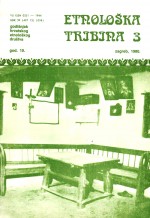Rasprostranjenost pojedinih tipova košnica u Jugoslaviji i pokušaj određivanja njihove relativne starosti
The Spreading of Particular types of Bee-Hives in Yugoslavia and the Attempt to Determine their relative Antiquity on our Territory
Author(s): Vlasta DomaćinovićSubject(s): Modern Age, Recent History (1900 till today), Cultural Anthropology / Ethnology, 15th Century
Published by: Hrvatsko etnološko društvo
Keywords: bee-hives; Yugoslavia; cultural change; Macedonia; Dalmatia; Panonia;
Summary/Abstract: Transformation of culture, although modern in investigation of the present moment, is not only the specialty of our time. Every great change of historical period was in fact a cultural change. In the past this process was very slow because the patterns did not reach all the people so quickly as to-day the west-European and american civilization does by means of TV , film and press. These new processes did not extend themselves everywhere the same, because somewhere the old, even the ancient, persisted up to now. Such very important historical events took place on our territory and manifested itself in some forms of beehives. In the Mediteran and some parts belonging to the old megalith culture, stone hives made out of stone blocks were built into a stone wall. Today such hives are known in the Baleares (Spain), Apulia (Italy) and on Brač and Hvar. Such had the old Romans too. Keeping the beehives in walls is not a rarity (Mediteran, Orient). This particular way of keeping bees reminds us of bee boles, niches in stone fences or walls of houses from the 15th - 18th century in England and on the Isle of Man. Before these stone hives, much simpler forms can be found in our country. There is a custom in preparing niches on the banks of rivers or in cliffs where wild bees come to swarm. People then take such swarms home and in this way the number of their bee-hives increase. This custom dominates in Macedonia and similar niches in stone are known in the parts around Obrovac. Som ething similar existed among the Čeramis on Volga Beehives in tree trunks are very ancient. The honey is collected from the bottom of the trunk and such beehives are known in the whole of the Roman Europe. The Slavs accepted this form probably because of its simple form and simple handling, and that's why we can explain its general expansion; while the Slavic form, the trunk bee-hive with a door opposite the flight of the bees, is rarely mentioned. Bee-hives in the form of standing boxes, show the same expansion as trunk bee-hives. The specialty of both in Dalmatia is a stone tile roof. In Slovinia such wooden boxes, in a horizontal line, completely belong to the alpen cultural areal and represents the youngest form of bee-hives in the Alps; they are thought to be late roman origin. No doubt the custom of keeping bees in stave vessels in northern Dalmatia belongs to the roman influence which appeared after 1st century A. D. Bee hives weaved from twigs, in the past existed in the whole country. In Panonia they were displaced with the straw weaved hives which cam e to our parts from the middle Europe through Hungary, and the Government of the Military Border intensively worked on their expansion.
Journal: Etnološka tribina : Godišnjak Hrvatskog etnološkog društva
- Issue Year: 1980
- Issue No: 10
- Page Range: 129-138
- Page Count: 10
- Language: Croatian

